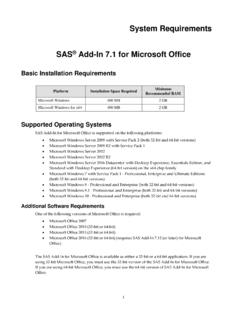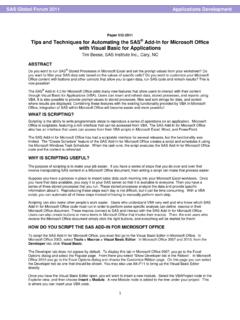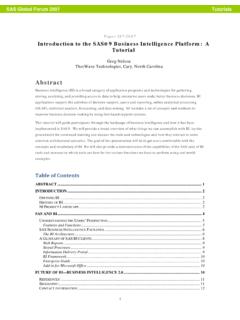Transcription of Leveraging SAS throughout the Organization from …
1 Paper 223-29 SAS Add-In for microsoft office Leveraging SAS throughout the Organization from microsoft office Jennifer Clegg, SAS Institute Inc., Cary, NC Stephen McDaniel, SAS Institute Inc., Cary, NC ABSTRACT The SAS Add-In for microsoft office is a Component Object Model (COM) add-in to microsoft Excel and microsoft Word. The SAS Add-In for microsoft office seamlessly exposes the power of SAS data access, reporting, and analytics directly from the familiar environment of microsoft office . This paper discusses the capabilities and features of the SAS Add-In for microsoft office Refer to Appendix A for a list of features by release. INTRODUCTION microsoft defines a COM add-in as a program that extends the capabilities of a microsoft office application.
2 The SAS Add-In for microsoft office uses this COM add-in technology to extend the data access, reporting, and analytic capabilities of microsoft Excel and microsoft Word. Once the SAS Add-In is installed, an integrated SAS menu and SAS toolbars are available as part of the office environment. Using the menu and toolbars you can directly access much of the power of SAS natively. The SAS Add-In for microsoft office works with SAS servers and later. Using the SAS Add-In for microsoft office you can access the power of SAS via three key mechanisms: 1) Data Access - the Add-In gives you the ability to open, query, sort, and browse data via the file system or SAS server accessible data sources (including third party data sources via SAS/ACCESS products) of any size directly from microsoft Excel.
3 A key advantage of this capability is the ability to access, browse, query, and analyze data sources larger than the Excel imposed row limit of 65,536. 2) SAS Stored Processes stored processes enable parameterized reporting and analysis. By Leveraging this capability, users can access a wide array of SAS content developed by business analysts, statisticians, and programmers. Stored processes are SAS programs that have been parameterized and registered to a SAS Metadata Server. 3) SAS Tasks - using tasks, you can do ad-hoc analysis to manage, summarize, and analyze Excel data or SAS data using a wide range of SAS capabilities, such as regression analysis, linear models, and forecasting.
4 SAS Stored Processes and SAS tasks generate results that display in the office application. ARCHITECTURE The SAS Add-In for microsoft office is a desktop client interface. When the Add-In for microsoft office installs, all necessary SAS components are also installed. No additional SAS install is required on the client PC. The SAS Add-In for microsoft office does require the microsoft .NET Framework. If the .NET Framework is not already on your PC, the SAS Add-In for microsoft office setup will install it. See Appendix B for a detailed list of system and software requirements for the SAS Add-In for microsoft office . For server side support, the SAS Add-In for microsoft office uses the SAS Foundation and SAS Foundation Servers of the SAS BI Infrastructure.
5 The SAS Foundation provides the SAS products to support the powerful data access and analytic capabilities of SAS. The SAS Foundation Servers include SAS Integration Technologies (IT) for enabling client-server communication. SAS Integration Technologies provides distributed object interfaces to SAS software features. SAS Integration Technologies provides access to the following servers used by the SAS Add-In for microsoft office . The SAS Metadata Server is a multi-user server that surfaces metadata from one or more SAS metadata repositories. A SAS metadata repository is a collection of related metadata objects that describe enterprise data resources. The SAS Metadata Server is the central information store for SAS products.
6 The SAS Add-In for microsoft office uses the SAS Metadata Server for identifying the servers, data sources, and stored processes. The SAS Metadata Server also provides the security model allowing you to restrict access by user or group to servers, data sources, and stored processes. The SAS Workspace Server provides a general purpose interface to the SAS Foundation. Clients can access data or submit SAS code for execution using the workspace server. The SAS Add-In for microsoft office uses the 1 SUGI 29 Systems Architectureworkspace server for accessing data sources on remote servers, for executing code generated by the SAS tasks, and for executing some stored processes.
7 The SAS Stored Process Server provides the preferred execution environment for stored processes. A stored process is a SAS program described by metadata. The stored process server provides a scalable platform for execution of stored processes from many clients. The SAS Add-In for microsoft office uses the stored process server to execute some stored processes. The SAS Object Spawner resides on the server host listening for requests. When a request is received, the object spawner authenticates the client connection and then redirects the request to an appropriate SAS server. If necessary, the object spawner launches the appropriate server (SAS Stored Process Server or SAS Workspace Server) to handle the request.
8 Copyright 2003, SAS Institute Inc. All rights SAS Application ServicesSAS BIInfrastructureSAS Intelligence ArchitectureSAS ClientServicesSAS Foundation ServersSAS Foundation ServicesSAS Query and Reporting ServicesDesktop ClientInterfacesDevelopmentEnvironmentWe b-based InterfacesPortalSAS COM ComponentsSAS Java ComponentsBase SAS SAS/CONNECT SAS/STAT SAS/SHARE SAS/ACCESS SAS/GRAPH SAS/QC SAS/ETS ..SAS Foundation ServicesSAS Foundation Servers DATA ACCESS One of the features of the SAS Add-In for microsoft office is the ability to open SAS data sources directly into microsoft Excel. This feature is not available from microsoft Word. Using the Open SAS Data Source dialog, you can open a data set via the file system or open a data source by navigating the servers and libraries.
9 The open data source dialog populates the list of servers by reading the metadata defined in the SAS Metadata Server. Similarly, the list of libraries displayed for each server is based on the metadata information as well. Each user may see a different view of the servers and libraries available, because the security model of the SAS Metadata Server restricts access to individual users based on the authorizations defined in the metadata. These permissions are defined by the administrator. Opening a data set via the file system uses the SAS OLE/DB local data provider technology. Regardless of whether you access data using local provider or the metadata server, you have the same features.
10 The difference in the two access mechanisms occurs when you perform a filter or sort operation. Using local data provider, all processing occurs on the client. Accessing data sources using the metadata server enables all the sorting and filtering to be performed on the server where the data resides. 2 SUGI 29 Systems ArchitectureWhen opening a data source, you can select which variables you want to view in Excel and the order in which you want to view those variables. You can also choose whether to use the names or labels of the variables as the column headings in Excel. Excel limits the number of columns in a single worksheet to 256. The SAS Add-In for microsoft office also has this limit.
















